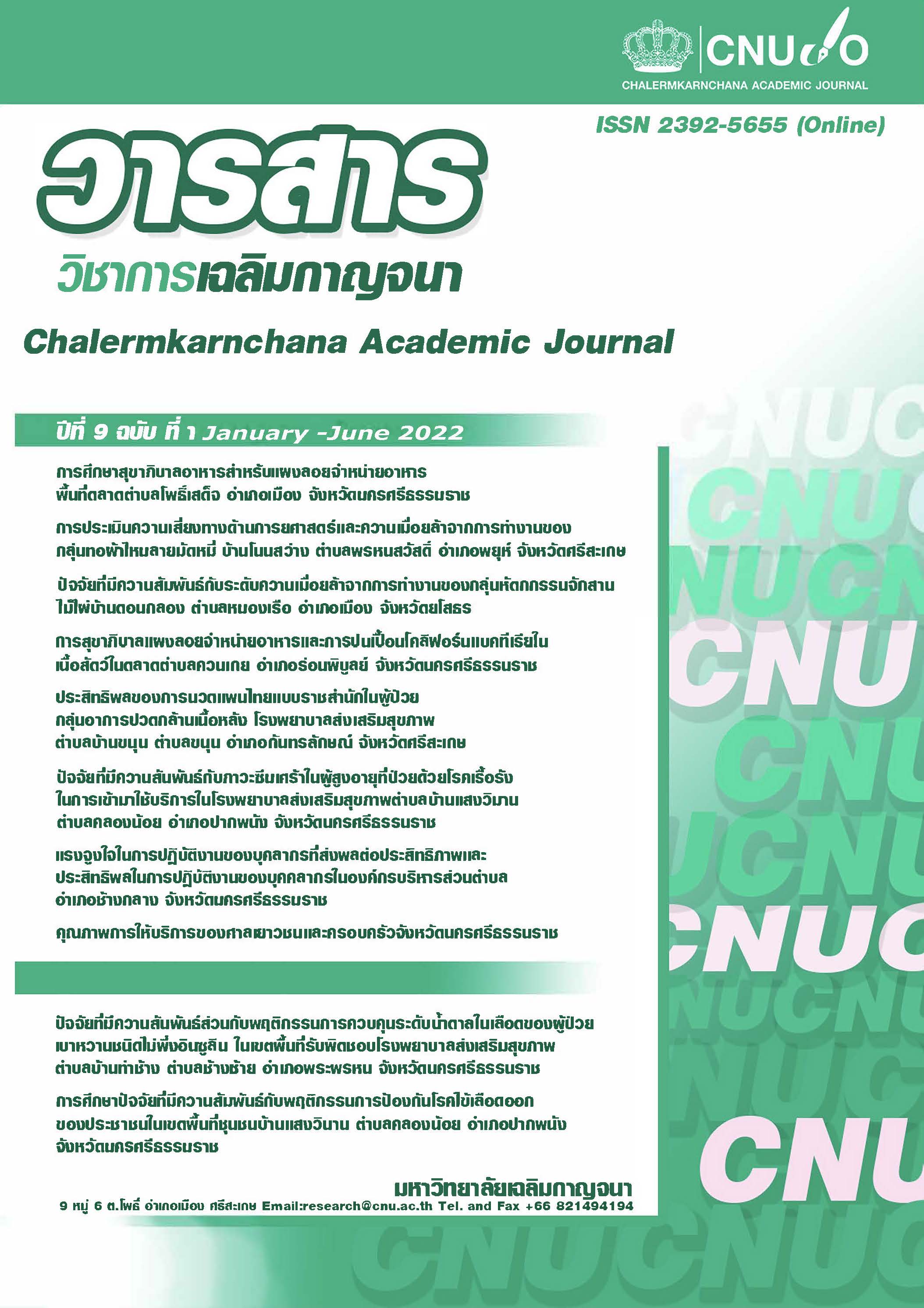Related factors to herbs self-care behaviors of people in Pho Sub-district, Muang District, Sisaket Province.
Abstract
This research is descriptive research. The objective was to study factors related to the behavior of using herbs for self-care among 400 people in Pho sub-district, Muang district, Sisaket province. The sample size was obtained from a simple random sampling In this study, taro Yamane sample size determination formulas (Yamane 1973: 580-581) were calculated at a 95% confidence level. The instrument used for data collection was a questionnaire created by the researchers. which has passed the content validity check from 3 qualified persons, verifying confidence by Cronbach's Alpha Method get a coefficient equal to 0.94 Data were analyzed by using descriptive statistics to find the values such as frequency, percentage, mean, standard deviation. The correlation was analyzed using quasi square statistic and Pearson correlation coefficient statistic.The results of the research found that 1. The behavior of using herbs for self-care of the sample group Overall and classified by aspects were at moderate level, on average equal to (× ̅=1.76, S. D=0.80).
- Knowledge about the use of herbs for self-care sample group Overall and classified by aspect were at low level, on average equal to (× ̅=0. 69, S. D=0.47).
- Knowledge about the use of herbs for self-care There was a positive correlation with the behavior of using herbs for self-care in the urinary system. statistically significant at the 0.05 level
4. Personal factors such as status, graduation, positive correlation with the behavior of using herbs for self-health care. Personal factors were sex, age, congenital disease, income, occupation and experience in using herbs. There was no positive correlation with the behavior of using herbs for self-care.
References
กนกกาญจน์ วิชาศิลป์และคณะ.(2559); การรับรู้ถึงสมุนไพรรักษาโรคของผู้บริโภคในภาค
ตะวันออกเฉียงเหนือของไทย. แก่นเกษตร. 44 ฉบับพิเศษ 1
กมลาภรณ์ คงสุขวิวัฒน์และคณะ.(2554). รายงานการวิจัยภูมิปัญญาพื้นบ้าน: กรณีศึกษาอาหารพื้นบ้าน
ไทยภาคเหนือ ตําบลแม่ทา กิ่งอําเภอแม่ออน จังหวัดเชียงใหม่ และตําบลเขาทอง อําเภอพยุหะศิรจังหวัดนครสวรรค์. พิมพ์ครั้งที่ 1. ศูนย์ฝึกอบรมและพัฒนาการสาธารณสุขมูลฐาน ภาคเหนือ จังหวัดนครสวรรค์.
กลยุทธ์ส่งเสริมการใช้ยาจากสมุนไพรแทนยาแผนปัจจุบัน 2559. [อินเตอร์เน็ต]. [ สืบค้นเมื่อวันที่ 15 ม.ค.
. จาก: http://rdo.psu.ac.th/images/D2/budget/strategic issues/5559 9.pdf
กองคุ้มครองภูมิปัญญาการแพทย์แผนไทยและการแพทย์พื้นบ้าน. กรมพัฒนาการแพทย์แผนไทยและ
การแพทย์ทางเลือก. อินเตอร์เน็ต]. สืบค้นเมื่อวันที่ 15 ม.ค.2564 ]; จากhttp://ptmk.dtam.moph.
go.th/home.php
โกมาตร จึงเสถียรทรัพย์. (2558) พหุลักษณ์ทางการแพทย์: มุมมองมานุษยวิทยากับความหลากหลายของ
วัฒนธรรมสุขภาพในพหุลักษณ์ทางการแพทย์กับสุขภาพในมิติสังคมวัฒนธรรม.กรุงเทพฯ: ศูนย์มานุษยวิทยาสิริธร. .
จารุวรรณ ศรีสร้อย, พิไลวรรณ ลี้พล, กาญจนา วงษ์สวัสดิ์.(2556) ปัจจัยที่มีผลต่อการบริโภคยาต้มสมุนไพร
ของประชาชนบ้านโคกลาย ตําบลม่วงลาย อําเภอเมือง จังหวัดสกลนคร. [อินเตอร์เน็ต].สืบค้นเมื่อวันที่ 15 ม.ค. 2564]. จาก: http://cph.snru.ac.th.
เตือนใจ อยู่ดี.(2554). ความรู้ในการใช้สมุนไพรของผู้มารับบริการจากโรงพยาบาลเจ้าพระยาอภัยภูเบศร
อําเภอเมืองจังหวัดปราจีนบุรี. วิทยานิพนธ์ปริญญามหาบัณฑิต.มหาวิทยาลัยเกษตรศาสตร์.นโยบายและทิศทางการขับเคลื่อนกรมการแพทย์แผนไทยและการแพทย์ทางเลือกปี 2558 – 2559. [อินเตอร์เน็ต]. [สืบค้นเมื่อวันที่ 15 ก.พ. 2564]; จาก: https://www.dtam.moph.go.th/index.php?lang=th
ปุญญพัฒน์ ไชยเมล์, ตั้ม บุญรอด, วิชชาดา สิมลา, (2554) .ปัจจัยที่มีผลต่อการใช้สมุนไพรในการดูแล
สุขภาพเบื้องต้นของประชาชน ตําบลแหลมโตนด อําเภอควนขนุน จังหวัดพัทลุง [อินเตอร์เน็ต].
[สืบค้นเมื่อวันที่ 17 มี.ค 2564]. จากhttp://digital_collect.lib.buu.ac.th/o js/index.php/health/article/view/2603
พาณี ศิริสะอาด. ภูมิปัญญาเพื่อสุขภาพ. ไทยนิวส์. 7 ม.ค. 2564: น. 5.
มาลิน จุลศิริ.(2557). รายงานการวิจัยเรื่องสารสกัดจากพืชเพื่อแก้โรคท้องร่วงท้องเดิน. ศูนย์ฝึกอบรมและ
พัฒนาสาธารณสุขอาเซียน.กรุงเทพฯ:. มหาวิทยาลัยมหิดล.
วิไลวรรณ ชัยณรงค์.(2554).ปัจจัยที่มีความสัมพันธ์กับพฤติกรรมการใช้สมุนไพรเพื่อรักษาเบื้องต้นของ
ประชาชนในเขต อ.ธัญบุรี จ.ปทุมธานี. วิทยานิพนธ์ปริญญามหาบัณฑิต มหาวิยาลัยเกษตรศาสตร์.
ศันสนีย์ ฤทธิ์ทองพิทักษ์.(2556).การเปิดรับข่าวสาร ความรู้ ทัศนคติ และการใช้สมุนไพรไทยของคนกรุงเทพมหานคร. วิทยานิพนธ์ปริญญามหาบัณฑิตจุฬาลงกรณ์มหาวิทยาลัย.
สํานักงานสถิติแห่งชาติ.(2557). การสํารวจพฤติกรรมการดูแลรักษาตนเองด้วยแพทย์แผนไทยและสมุนไพร
ของครัวเรือน พ.ศ. 2556. [อินเตอร์เน็ต]. [สืบค้นเมื่อวันที่ 15 มีนาคม 2564. จาก: https://www.m-society.go.th/article_attach/11617/15921.pdf
สุกิจ ไชยชมภู.(2555). ปัจจัยที่มีความสัมพันธ์กับพฤติกรรมการใช้สมุนไพรรักษาโรคของประชาชนในเขต
กระทรวงสาธารณสุข. วารสารเกื้อการุณย์.;19(2):60-74.
สุนีย์ แป้นทะเล.(2552) การศึกษาพฤติกรรมการใช้สมุนไพรเพื่อการดูแลสุขภาพของคนในชุมชนเครือข่าย
ป่าตะวันออก กรณีศึกษา บ้านนาอีสาน หมู่ที่ 16 ตําบลท่ากระดาน อําเภอสนามชัย จังหวัดฉะเชิงเทรา.[วิทยานิพนธ์ปริญญามหาบัณฑิต มหาวิทยาลัยเทคโนโลยีพระจอมเกล้าธนบุรี. .
Gedif, T. and J. Hahn. (2003). The use of medicinal plants in self-care in rural central
Ethiopia. Journal of Ethnopharmacology.6(8):155-61.
Taro Yamane. (1967). Statistics: An Intro-ductory Analysis.N.Y. Harper and Row 1967 p.886 (Mimeographed.)
Downloads
Published
How to Cite
Issue
Section
License

This work is licensed under a Creative Commons Attribution-NonCommercial-NoDerivatives 4.0 International License.






